FIRST, A DEFINITION
Isometric (equal length) exercise is a form of workout involving the static contraction of a muscle without any movement in the angle of the joint. The working muscles do not change length as tension is applied.
An example would be the classic plank.
Isotonic (equal tension) exercises involve a range of motion. Your muscles are either lengthened or shortened while using the same amount of tension as your joints are moved.
Examples are bench presses, biceps curls and even walking or swimming.
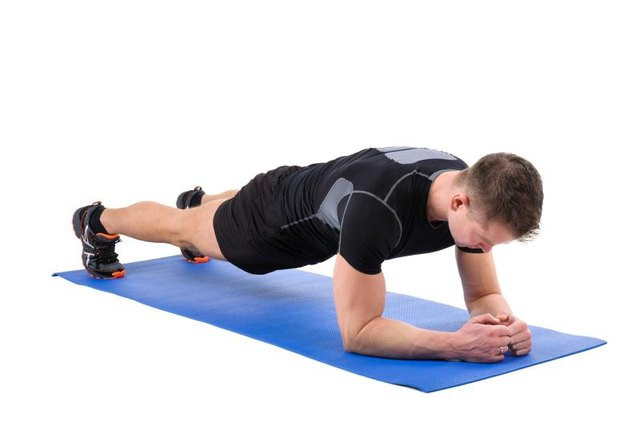
Obviously, isometric forms of exercise are not used nearly so much as isotonic movements in most workout routines with free weights, machines or even bodyweight exercises.
Isometric exercises are static – stationary and low impact (at least compared to isotonic exercise). They are especially effective for those recovering from injury, surgery or joint pain.
I have recently begun to do isometric exercises because I have nerve pain in my back due to sciatica or spinal stenosis. At this point, I want brief workouts that don’t involve long reps or bending of my body.
BENEFITS OF ISOMETRIC EXERCISE
The Coumbia Association tells us that isometric exercise helps us in these ways:
- Improvement of bone density
- Maintenance of strength and stability
- Reduction of arthritis pain
- Improvement of cholesterol levels
- Lowering of blood pressure
Medical News Today adds that isometric exercise:
- Activates many muscle fibers at once
- Requires less practice to perform the exercises with correct form
- According to research, may relieve pain in the lower back, knees and neck
It has been well-established that isometrics are generally safe, easy to do and effective in building and maintaining strength.
The biggest benefit, based on my research, seems to be joint stability. Unstable or injured joints are improved as the nearby muscles are worked without a range of motion that could be painful.
Isometric exercises work, since they activate muscle fiber. Equal forces are working against each other, but without movement. This triggers the muscle fiber.
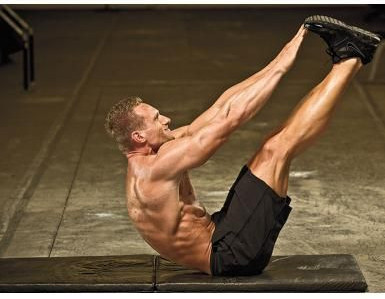
THE BEST BODYWEIGHT ISOMETRIC EXERCISES
Forearm plank – this is shown in my top image. The abdominal muscles are worked. Correct form is essential. Your spine is straight and your core area is tightened. This is my favorite core exercise.
V-up hold – see the above image. Legs and arms are extended forward, with knees and arms locked. This is an example that just about any exercise movement may be held at a concentric point and made into an isometric exercise
Side plank – this works the obliques, spinal stabilizers, glutes and hip abductors. Lying on your left side, keep your legs straight, with hips, knees and feet stacked. Then push your left forearm into the surface and lift your torso. See below.
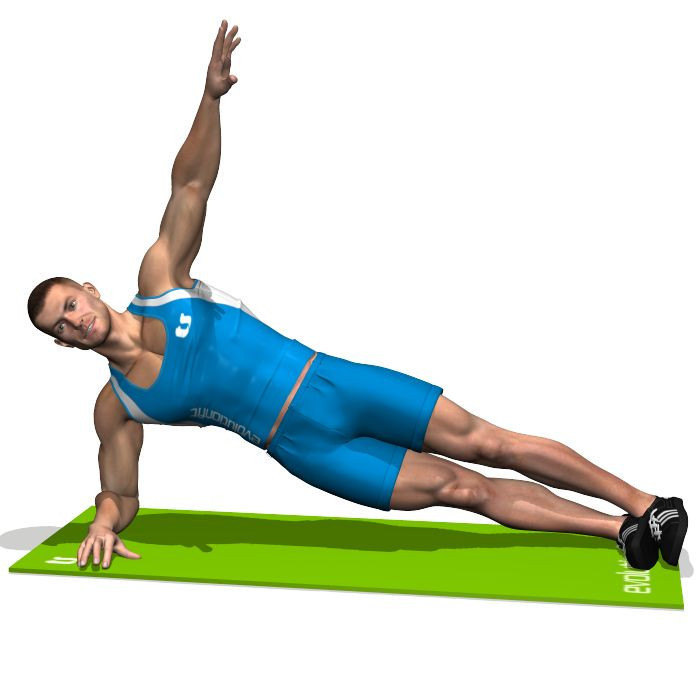
Arm wrestling – don’t laugh. Place your hands together at a 90 degree angle. Push your hands together as hard as you can without moving either hand. Note the effect on your biceps and triceps. I also feel it in my pectorals.
Glute bridge – on your back with knees bent upward, raise your hips off the floor until your torso is straight. This is great for your gluteal muscles, the largest muscles in your body. See below, Ben Affleck.
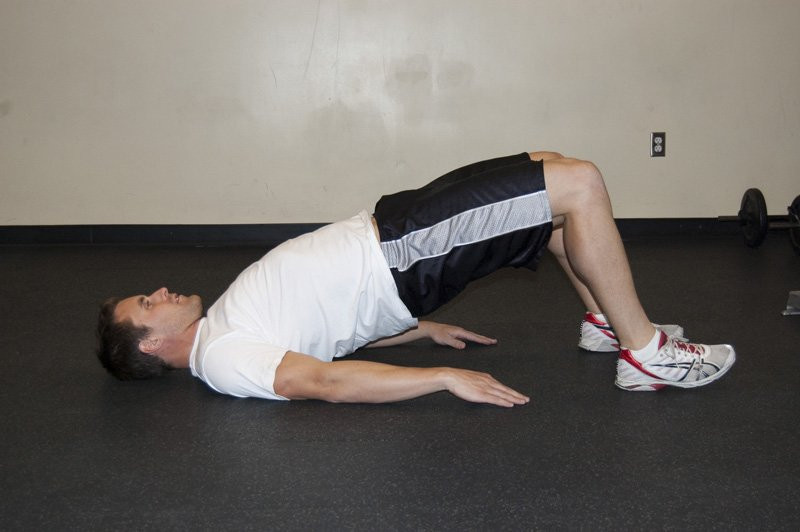
Wall sit – a great leg exercise. Stand about two feet from a wall, facing away from the wall. Then lean toward the wall until your back is flat against it. Slide down from the wall until your thighs are parallel to the ground. Hold this position, with support by the wall.
Wall triceps extension – lean against a wall, with your hands against the wall at head level. Push the wall with your triceps, relaxing your shoulders. Be sure your hands are at head level.
High plank – in the beginning of a push-up position, press the floor and keep your spine straight. This works your back and core.
Dead hang – pull up to a bar, with hands shoulder width apart. Feet off the floor, hang from the bar. Push feet out, if you can hold this position. Or just hang.
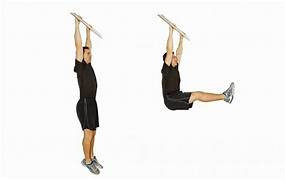
Calf raise and hold – two feet from a wall, resting your hands very lightly against the wall, raise your heels off the ground and hold.
Two points to make:
- The length of the hold may be in question. I personally like to hold the tension as long as I can. There are those who prefer to hold 7-10 seconds. The benefit of a shorter hold may be the possibility of a quicker and faster workout.
- Isometric exercises are unlimited. The above illustrations are of the ones more commonly used. The concentric part of any exercise is the “working” part. For example, the concentric part of a biceps curl is the curl itself. The eccentric part is the lowering of the weight or the return to the starting position. Any exercise may be halted and held after the concentric part is done and this creates an isometric exercise.
THE BEST WAY TO DO ISOMETRIC EXERCISES
This is just my opinion, but I doubt if many people will disagree.
Bullworker Fitness makes exercise tools that are specifically designed for isometrics.
Not only that, but isotonic movements can be done with the same tools. An isotonic movement may precede the isometric hold or the isometric hold may come first.
A strictly isometric workout routine may be done or one may choose an isotonic program. I like to combine the two, but I am now temporarily experimenting with isometrics alone.
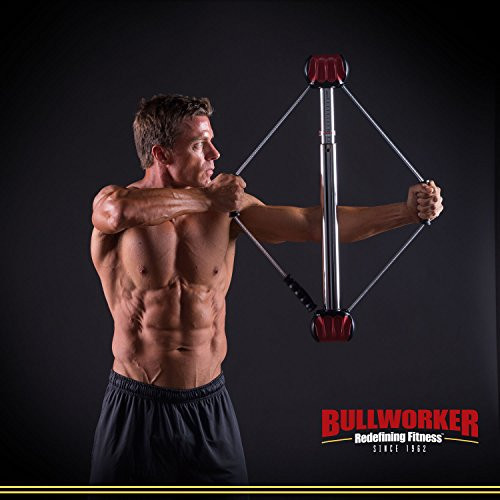
The above illustration shows the use of the Bow Classic and the archer exercise. The archer movement is done on the right and left sides of your body and is an excellent back (latissimus dorsi) developer. After reps are done (or before if you prefer) , the two spread handles may be held in the.position shown.
I have the Bow Classic and the Steel Bow. The Steel Bow is somewhat smaller and works better for me in the chest compression exercise, great for pectoral development. Also, the Steel Bow is good as a traveling tool, to assure that we have a workout possibility at all times.
With the Bow Classic and/or the Steel Bow, hundreds of isometric exercises are possible. In general, we are either compressing the red handles or spreading the black handles against the resistance within the cylinder. That resistance is provided by springs of different “weight”. The springs are changed as easily as barbell or dumbbell plates are.
We are able to go from our final rep directly into the isometric or “hold” mode of Bullworkers immediately – no waste of time and there is added intensity to the movement.
With every Bullworker delivery, a handbook is included with pictures and explanations of possible workouts.
Here is my prior post on isometric vs, isotonic training.
A young but seasoned bodybuilder compares free weights with Bullworkers in this video. He likes both.
The Bullworker website provides information on all of their products.
FINAL THOUGHTS
My main reason for working out with the Bullworkers and for planking instead of crunching for my core is to avoid further spinal pain.
It is nice to have this alternative to free weights. Bullworker exercise movements are easy to understand and the holds at the end are very productive. So are the reps.
In my opinion, it is generally helpful to change workout modes occasionally anyway. This renews my enthusiasm and keeps me on track.
For those who want greater resistances, there are springs to use within the Bullworkers that will challenge anyone.
Martial arts expert Bruce Lee used a Bullworker to develop strength as a young man.
Isometric exercises, in general, are important adjuncts to any fitness program and can become the most essential part when needed.
Please leave me any comments or questions in the “Comments” section below. Or email me, richard@myworkoutathome.com.
Be well and stay fit!
.